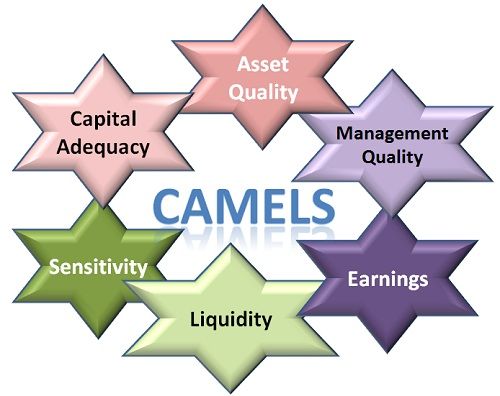Definition: CAMELS Rating is the rating system wherein the bank regulators or examiners (generally the officers trained by RBI), evaluates an overall performance of the banks and determine their strengths and weaknesses.
CAMELS Rating is based on the financial statements of the banks, Viz. Profit and loss account, balance sheet and on-site examination by the bank regulators. In this Rating system, the officers rate the banks on a scale from 1 to 5, where 1 is the best and 5 is the worst. The parameters on the basis of which the ratings are done are represented by an acronym “CAMELS”.
- Capital Adequacy: The capital adequacy measures the bank’s capacity to handle the losses and meet all its obligations towards the customers without ceasing its operations.This can be met only on the basis of an amount and the quality of capital, a bank can access. A ratio of Capital to Risk Weighted Assets determines the bank’s capital adequacy.
- Asset Quality: An asset represents all the assets of the bank, Viz. Current and fixed, loans, investments, real estates and all the off-balance sheet transactions. Through this indicator, the performance of an asset can be evaluated. The ratio of Gross Non-Performing Loans to Gross Advances is one of the criteria to evaluate the effectiveness of credit decisions made by the bankers.
- Management Quality: The board of directors and top-level managers are the key persons who are responsible for the successful functioning of the banking operations. Through this parameter, the effectiveness of the management is checked out such as, how well they respond to the changing market conditions, how well the duties and responsibilities are delegated, how well the compensation policies and job descriptions are designed, etc.
- Earnings: Income from all the operations, non-traditional and extraordinary sources constitute the earnings of a bank. Through this parameter, the bank’s efficiency is checked with respect to its capital adequacy to cover all the potential losses and the ability to pay off the dividends.Return on Assets Ratio measures the earnings of the banks.
- Liquidity: The bank’s ability to convert assets into cash is called as liquidity. The ratio of Cash maintained by Banks and Balance with the Central Bank to Total Assets determines the liquidity of the bank.
- Sensitivity to Market Risk: Through this parameter, the bank’s sensitivity towards the changing market conditions is checked, i.e. how adverse changes in the interest rates, foreign exchange rates, commodity prices, fixed assets will affect the bank and its operations.
Thus, through CAMELS rating, the overall financial position of the bank is evaluated and the corrective actions, if any, are taken accordingly.


masia says
Nice 😄
Khalid Ahmed says
Interesting and useful for professionals
Ayogoi says
This is very expository..nice read
hosea waiyaki says
I like the explanation. It is awesome
Amanuel Tafesse says
I got excessive exposures from the handsome explanation about financial soundness indicators (CAMELS). Stay blessed!!!
Usman Garba Musa says
I’m ever thankful for such a wonderful explanation on Camel rating system